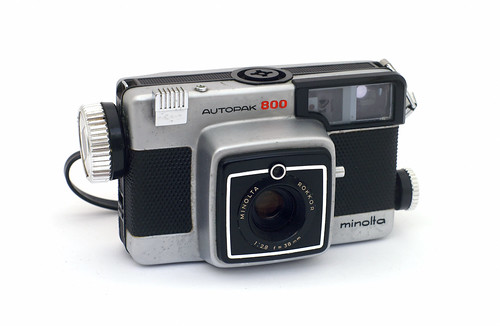Difference between revisions of "Minolta Autopak 800"
m (minimal cat) |
m (minor cleanup & rewording) |
||
| Line 6: | Line 6: | ||
}} | }} | ||
| − | In 1969, when Neil Armstrong set | + | In 1969, when Neil Armstrong set foot on the Moon, there was a great demand for easy-to-use cameras on Earth that may have been set off some years earlier by Kodak's 126 film cartridge system. The '''Minolta Autopak 800''' was a rangefinder camera for this format. It had a built-in mechanical clockwork for automatic film advance that could be wound up for making a series of 12 exposures. Like many other cameras for the format, it had a connector for flashcubes that turned 90 degrees after each exposure to get the next of four bulbs into firing position. |
| + | |||
<small> | <small> | ||
| − | *Type: viewfinder camera | + | *Type: viewfinder film camera |
*Manufacturer: [[Minolta]] | *Manufacturer: [[Minolta]] | ||
*Year of launch: 1969 | *Year of launch: 1969 | ||
| − | *Film: | + | *Film: 126 film cartridge |
| − | *Lens: [[Rokkor]] 1:2.8/38mm | + | *Lens: [[Rokkor]] 1:2.8/38mm 4-element glass |
*Viewfinder: bright frame finder with coupled rangefinder | *Viewfinder: bright frame finder with coupled rangefinder | ||
*Shutter: speeds 1/45 sec. in flash mode, otherwise 1/90 sec. | *Shutter: speeds 1/45 sec. in flash mode, otherwise 1/90 sec. | ||
| − | *Aperture: automatically controlled by | + | *Aperture: automatically controlled by CdS light sensor over the lens |
*Film advance: clockwork motor | *Film advance: clockwork motor | ||
| − | *Dimensions: 125×78×58mm | + | *Dimensions: 125 × 78 × 58mm |
*Weight: 520 g | *Weight: 520 g | ||
</small> | </small> | ||
Revision as of 16:24, 4 June 2007

|
| click on image to get more info |
In 1969, when Neil Armstrong set foot on the Moon, there was a great demand for easy-to-use cameras on Earth that may have been set off some years earlier by Kodak's 126 film cartridge system. The Minolta Autopak 800 was a rangefinder camera for this format. It had a built-in mechanical clockwork for automatic film advance that could be wound up for making a series of 12 exposures. Like many other cameras for the format, it had a connector for flashcubes that turned 90 degrees after each exposure to get the next of four bulbs into firing position.
- Type: viewfinder film camera
- Manufacturer: Minolta
- Year of launch: 1969
- Film: 126 film cartridge
- Lens: Rokkor 1:2.8/38mm 4-element glass
- Viewfinder: bright frame finder with coupled rangefinder
- Shutter: speeds 1/45 sec. in flash mode, otherwise 1/90 sec.
- Aperture: automatically controlled by CdS light sensor over the lens
- Film advance: clockwork motor
- Dimensions: 125 × 78 × 58mm
- Weight: 520 g